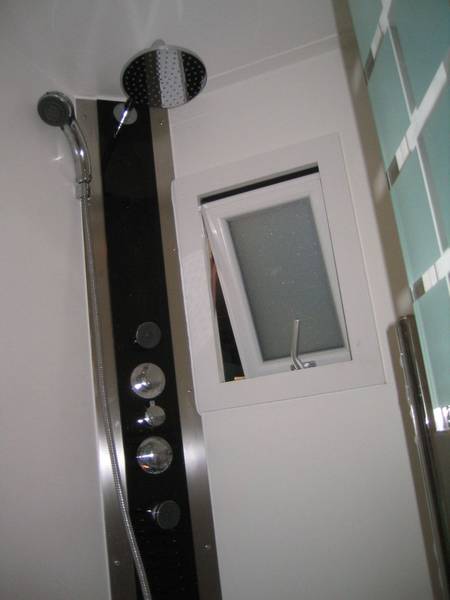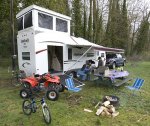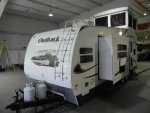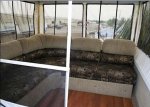biotect
Designer
egn,
Yes, you are right about the need to work up two different designs - :iagree:
It doesn’t have to be either/or, does it? It can be both/and.
Indeed, given that the aesthetic and ergonomic “prejudices” of the European and North American markets are now in some ways different, from a purely marketing point of view it makes sense to develop two concepts in parallel: one that’s a Pusher, and the other that’s CBE.
So, with that in mind: on your old Concorde LinerPlus, how much volume did your engine occupy in back? Your Concorde diesel engine was located under the bed, right? Even the roughest possible guesstimate here would be better than none. The axle clearance for your Concorde was 30 cm? 40 cm? And the top of the engine volume (or the bottom of the bed platform, which is was more or less the same thing?) was how many cm above grade? 100 cm? 80 cm? This would then provide a rough approximation of the height of the volume that contained your Diesel engine. What was the brand of the engine?
Even more importantly, would you know what chassis current Concorde LinerPlus motorhomes use? I searched the Concorde website, but could not seem to find the answer.
Here my main initial concern will be the height of the engine volume. Sure, everything will ultimately depend on the size, make, and format of the engine. But at least initially, I am only looking for very rough, “ball-park” figures.
More relevant than going into detailed investigation of engines, will be looking into Class A Pusher designs, and their typical engine volumes in the rear. In American Class-A and German "Liner" motorhome design there is strong pressure to minimize the volume occupied by the engine, thereby maximizing space available for everything else. But, by the same token, there is also strong pressure at the top end of the market to provide Class-A motorhomes with the most powerful Diesel engines possible, especially in terms of torque. So if any market-segment has been trying hard to figure out how to pack the most powerful Diesel engine possible, into the smallest, flattest volume, it would be the Class-A and Liner “Pusher” niche markets.
I am still very much committed to a rear-deck design. But if it’s possible to fit a super-flat Diesel engine into the space in back between the rear axle ground clearance of a Tatra 815 or MAN SX-45, and, say, 1.6 m above grade, then maybe a “Pusher” engine placement would work after all. In pictures of the Concorde LinerPlus bedroom, the bed was not 2 m off the ground, so there seems to be a fairly “flat” Diesel engine located underneath it.
Luckily, the list of American manufacturers of Class A “Pusher” chassis is fairly short – see http://www.rv-info.net/rvchassis.html , http://www.workhorse.com , http://www.spartanmotors.com , http://www.mcicoach.com , http://www.prevostcar.com , http://www.roadmasterchassis.com , and http://www.daimler-trucksnorthamerica.com/brands/freightliner-custom-chassis.aspx . Typically American RV fabricators such as Winnebago, Fleetwood, etc. will focus only on the "camper box", setting their box on top of a chassis provided by Freightliner, Ford, etc. And no doubt in the German Liner market things are similar? But a few American RV fabricators will custom-design their own chassis, for obvious enough reasons: it gives them greater design flexibility and control. Tiffin motorhomes has its “Powerglide” chassis, Country Coach had (past tense) their “Dynamax” chassis, and Alpine Coach had (past tense) their “Peak Chassis” – see http://tiffinmotorhomes.com , http://www.rvcruzer.com/powerglide.php , http://www.rvcruzer.com/tiffin_powerglide.php , http://www.rvtechlibrary.com/chassis/powerglide.pdf , http://sherry-c-fanning.blogspot.it/2012/02/normal-0-false-false-false.html , http://www.alpinecoachassociation.com/brochures/2005Peak.pdf . And of course Newell custom-constructs its own Pusher chassis.
For my purposes, probably the most indicative will be the UFO chassis, because in this chassis Workhorse tried exceptionally hard to “flatten” the engine, and make it as low-height as possible. See my post with lots of pictures on page 12, labeled number 9, at http://www.expeditionportal.com/for...orsion-Free-Frame/page12?highlight=integrated; and here are a few of those same images again:

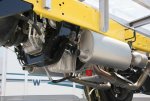


The Workhorse UFO chassis probably represents the “flattest”, most low-height arrangement for a Pusher Diesel engine possible. I’m now digging around various websites to see if I can find a really good, side-elevation schematic for a UFO chassis.
Now egn, if you might know where I could find an equivalently “short” list of German “Liner” motorhome chassis manufacturers, that would also be great – i.e. a German list similar to the very short American list at http://www.rv-info.net/rvchassis.html . I searched for about two hours using google.de, and came up with überhaupt nichts..... Again, it's not the chassis specifically that I am interested in, because that will be either a Tatra 815 or a MAN SX-45. Rather, I am only interested in how they locate, compress, and otherwise flatten the "Pusher" Diesel engine in back.
Again, it's not the chassis specifically that I am interested in, because that will be either a Tatra 815 or a MAN SX-45. Rather, I am only interested in how they locate, compress, and otherwise flatten the "Pusher" Diesel engine in back.
And finally, if you (or anyone else reading this) knows of other “super-flat Pusher engine placements”, and would be willing to post links here in this thread – especially to photographs or elevations – that would be also be terrific!
All best wishes,
Biotect
Yes, you are right about the need to work up two different designs - :iagree:
It doesn’t have to be either/or, does it? It can be both/and.
Indeed, given that the aesthetic and ergonomic “prejudices” of the European and North American markets are now in some ways different, from a purely marketing point of view it makes sense to develop two concepts in parallel: one that’s a Pusher, and the other that’s CBE.
So, with that in mind: on your old Concorde LinerPlus, how much volume did your engine occupy in back? Your Concorde diesel engine was located under the bed, right? Even the roughest possible guesstimate here would be better than none. The axle clearance for your Concorde was 30 cm? 40 cm? And the top of the engine volume (or the bottom of the bed platform, which is was more or less the same thing?) was how many cm above grade? 100 cm? 80 cm? This would then provide a rough approximation of the height of the volume that contained your Diesel engine. What was the brand of the engine?
Even more importantly, would you know what chassis current Concorde LinerPlus motorhomes use? I searched the Concorde website, but could not seem to find the answer.
Here my main initial concern will be the height of the engine volume. Sure, everything will ultimately depend on the size, make, and format of the engine. But at least initially, I am only looking for very rough, “ball-park” figures.
More relevant than going into detailed investigation of engines, will be looking into Class A Pusher designs, and their typical engine volumes in the rear. In American Class-A and German "Liner" motorhome design there is strong pressure to minimize the volume occupied by the engine, thereby maximizing space available for everything else. But, by the same token, there is also strong pressure at the top end of the market to provide Class-A motorhomes with the most powerful Diesel engines possible, especially in terms of torque. So if any market-segment has been trying hard to figure out how to pack the most powerful Diesel engine possible, into the smallest, flattest volume, it would be the Class-A and Liner “Pusher” niche markets.
I am still very much committed to a rear-deck design. But if it’s possible to fit a super-flat Diesel engine into the space in back between the rear axle ground clearance of a Tatra 815 or MAN SX-45, and, say, 1.6 m above grade, then maybe a “Pusher” engine placement would work after all. In pictures of the Concorde LinerPlus bedroom, the bed was not 2 m off the ground, so there seems to be a fairly “flat” Diesel engine located underneath it.
Luckily, the list of American manufacturers of Class A “Pusher” chassis is fairly short – see http://www.rv-info.net/rvchassis.html , http://www.workhorse.com , http://www.spartanmotors.com , http://www.mcicoach.com , http://www.prevostcar.com , http://www.roadmasterchassis.com , and http://www.daimler-trucksnorthamerica.com/brands/freightliner-custom-chassis.aspx . Typically American RV fabricators such as Winnebago, Fleetwood, etc. will focus only on the "camper box", setting their box on top of a chassis provided by Freightliner, Ford, etc. And no doubt in the German Liner market things are similar? But a few American RV fabricators will custom-design their own chassis, for obvious enough reasons: it gives them greater design flexibility and control. Tiffin motorhomes has its “Powerglide” chassis, Country Coach had (past tense) their “Dynamax” chassis, and Alpine Coach had (past tense) their “Peak Chassis” – see http://tiffinmotorhomes.com , http://www.rvcruzer.com/powerglide.php , http://www.rvcruzer.com/tiffin_powerglide.php , http://www.rvtechlibrary.com/chassis/powerglide.pdf , http://sherry-c-fanning.blogspot.it/2012/02/normal-0-false-false-false.html , http://www.alpinecoachassociation.com/brochures/2005Peak.pdf . And of course Newell custom-constructs its own Pusher chassis.
For my purposes, probably the most indicative will be the UFO chassis, because in this chassis Workhorse tried exceptionally hard to “flatten” the engine, and make it as low-height as possible. See my post with lots of pictures on page 12, labeled number 9, at http://www.expeditionportal.com/for...orsion-Free-Frame/page12?highlight=integrated; and here are a few of those same images again:




The Workhorse UFO chassis probably represents the “flattest”, most low-height arrangement for a Pusher Diesel engine possible. I’m now digging around various websites to see if I can find a really good, side-elevation schematic for a UFO chassis.
Now egn, if you might know where I could find an equivalently “short” list of German “Liner” motorhome chassis manufacturers, that would also be great – i.e. a German list similar to the very short American list at http://www.rv-info.net/rvchassis.html . I searched for about two hours using google.de, and came up with überhaupt nichts.....
And finally, if you (or anyone else reading this) knows of other “super-flat Pusher engine placements”, and would be willing to post links here in this thread – especially to photographs or elevations – that would be also be terrific!
All best wishes,
Biotect
Last edited:

